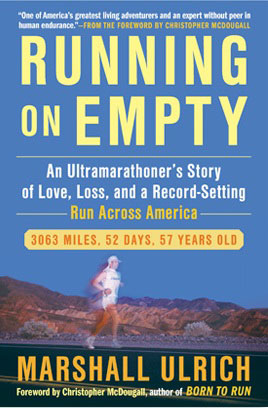Ultramarathoner Marshall Ulrich Defies Age Barriers, Inspires With Tales of Love, Loss and Motivation
- Published: Wednesday, September 7th 2011
- in Fitness
 Have you heard of Marshall Ulrich? Three years ago, at the age of 57, he ran two marathons and a 10K every day for nearly two months straight, clocking the third-fastest trans-American crossing from San Francisco to New York City. He also set new records in multiple divisions and climbed Mount Everest. And right when we talked to him about motivation and goals, fitness and wellness, defying age barriers and of course, his thoughts on spa, he was at the Las Vegas airport, waiting for his flight to Switzerland to celebrate his 60th birthday with two mountain climbs in the same week, one being Mount Eiger (13,025 feet) and the other, the Matterhorn (14,692 feet). This was right after he finished running 146 miles across the hottest place on earth, Death Valley.
Have you heard of Marshall Ulrich? Three years ago, at the age of 57, he ran two marathons and a 10K every day for nearly two months straight, clocking the third-fastest trans-American crossing from San Francisco to New York City. He also set new records in multiple divisions and climbed Mount Everest. And right when we talked to him about motivation and goals, fitness and wellness, defying age barriers and of course, his thoughts on spa, he was at the Las Vegas airport, waiting for his flight to Switzerland to celebrate his 60th birthday with two mountain climbs in the same week, one being Mount Eiger (13,025 feet) and the other, the Matterhorn (14,692 feet). This was right after he finished running 146 miles across the hottest place on earth, Death Valley.
“I want to encourage people not to dwell on some number, but instead to think of themselves as being healthy and vital regardless of their age, and to act on that,” Ulrich tells SpaFinder. “Sometimes it’s about approaching things in new ways.”
In his exceptionally inspiring and motivational life story, Running on Empty: An Ultramarathoner’s Story of Love, Loss, and a Record-setting Run Across America, Ulrich gives readers insight to how he got into running and climbing, and how he stays physically, mentally and spiritually well through his extreme athletic pursuits, along with nurturing other aspects of his life. We asked him a few questions, and we hope his answers will inspire and motivate all of you.
• What was your motivation in tackling these hugely ambitious feats, and how did you stick to your goals? Where did you get the ideas to do such things like running 3,063 miles across the U.S. and 146 miles across the hottest place on earth?
 MU: When my wife, Jean, was diagnosed with breast cancer, my blood pressure went through the roof, so on a doctor’s advice, I started running short distances. It worked to bring the BP down and gave me a release valve for all of the stresses of that time. As Jean got more and more ill, and I became more and more frightened she would die, I increased my distance (both literally and figuratively) as a way of coping. In 1981, she died when we were both thirty years old.
MU: When my wife, Jean, was diagnosed with breast cancer, my blood pressure went through the roof, so on a doctor’s advice, I started running short distances. It worked to bring the BP down and gave me a release valve for all of the stresses of that time. As Jean got more and more ill, and I became more and more frightened she would die, I increased my distance (both literally and figuratively) as a way of coping. In 1981, she died when we were both thirty years old.
After that, I just kept going. I worked up to the 146-mile race across Death Valley incrementally. I graduated to 50-milers, and then 24-hour and 48-hour races, and that’s when I discovered I had a talent for endurance. For years, doing ultra-distances came from the need to prove something to myself, and to punish myself, too, because of my survivor’s guilt. At the same time, as difficult as extreme endurance running is, there’s peace and quiet, there’s time to think or escape or be creative. It teaches you about yourself in ways few other things do.
Once I reached the elite level of ultra-runners in my forties, I was motivated by a desire to contribute something unique to the sport, so I started inventing unprecedented and somewhat outrageous tests, things like doing the [Death Valley] Badwater course unassisted and unaided, meaning I pulled all my supplies in a cart that started out weighing about 200 pounds, and also doing that same course four times, back to back, for a total of about 600 miles.
• What’s your advice for people looking to defy age barriers as you have – whether it be ambitious feats like yours, running in a marathon, or taking up a new fitness routine?
MU: Never stop looking for the new thing that you’re excited to do. It’s a matter of paying attention, not ever considering yourself “done.” For me, regularly redefining myself and attempting new things keeps it challenging and fresh. No matter what your age, keep climbing.
• How do you stay physically and mentally fit?
MU: My regular routine is running four or five times a week, and taking a few days off. And as important as the activity days are, the rest days are just as important. I also usually take November and December off altogether, which allows my body and mind to recover, rebalancing my perspective and my priorities. Intensity interspersed with real rest helps me come back with a new attitude, hungry to take on something new, so the physical and mental complement each other.
Probably most important is my relationship with my wife, Heather, who knows me better than anyone and is a kind of barometer of my emotional and mental health. She helps remind me when to focus on something other than the athletic achievements, has shown me over and over again how much I need and depend on key relationships, how important it is to give love and to receive it from her, my family and our friends.
• Do you ever go to the spa? If so, what’s your favorite treatment?
MU: My wife, Heather, and I went down to a spa in Ixtapa near South Chiluca, Mexico, after the run across America as a treat for her. Believe me, she deserved it! Not only had she served as my key emotional support during that effort, but she’d also taken long shifts as a member of my crew and also taken the brunt of the organizational tasks, coordination with a film crew that was documenting the whole thing and more. While I was out there putting in the miles, she was putting up with an awful lot herself.
So yes, we went together, and I had cucumbers on my eyes and some kind of salad dressing in my hair, the works. Seriously, we had massages every day, which was my favorite. I liked being pampered ─ I highly recommend it! I’m not so macho that I can’t enjoy that sort of thing. Spas are great!


